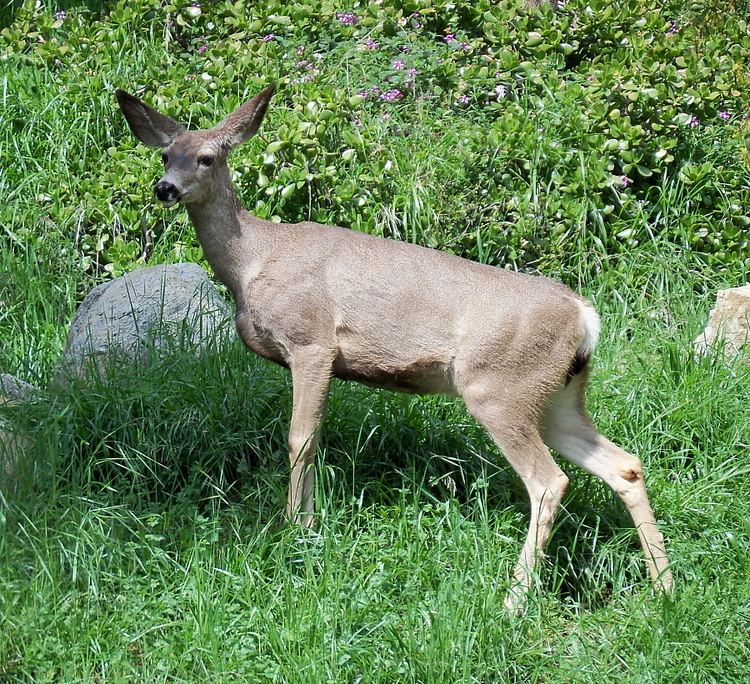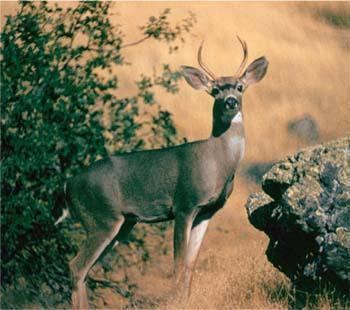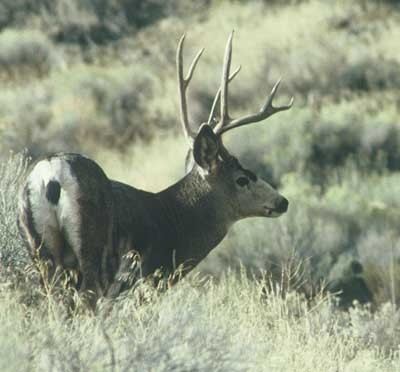Order Artiodactyla Higher classification Mule deer | Phylum Chordata Family Cervidae Rank Subspecies | |
Scientific name Odocoileus hemionus californicus Similar Mule deer, Deer, Odocoileus, Mammal, Sitka deer | ||
California mule deer (Odocoileus hemionus californicus) is a subspecies of mule deer whose range covers much of the state of California.
Contents

Anatomy

One of the principal means of distinguishing the closely related black-tailed deer and white-tailed deer is the growth habit of the buck's antlers. In the case of the California mule deer, the antlers fork in an upward growth, whereas the other species' antlers grow in a forward direction.
Distribution

This subspecies, Odocoileus hemionus californicus, is widespread throughout northern and central California in the California coastal prairie as well as inner coastal ranges and interior mountains, especially the Sierra Nevada. This deer will much less frequently be found on the floor of the interior valleys, and then it will mostly frequent riparian zones.
Habitat

Generally, the California mule deer has a preference for hill terrain, especially an oak woodland habitat. It is a browser and will typically take over ninety percent of its diet from shrubs and leaves and the balance from grasses.
Diet and behavior
California mule deer usually browse close to lakes or streams providing their water source. From that reference point of water consumption they may roam one to two miles, and typically make their beds in grassy areas beneath trees within such a one-mile distance radius from both water and forage.
Repeated beds will often be scratched to a nearly level surface, about two meters in diameter. Less regularly used bedding areas are manifested as flattened grass. On hot summer days California mule deer often seek shade and rest in the mid-day.
In summer, California mule deer mainly browse on leaves of small trees, shrubs and herbaceous plants, but also consume many types of berry (including blackberry, huckleberry, salal and thimbleberry). In winter, they may expand their forage to conifers (particularly twigs of Douglas fir), aspen, willow, dogwood, juniper, and sage. Year-round, they will feed on acorns; grasses are a secondary food source. Where humans have encroached on historic deer habitat by suburban development or orchards, California mule deer will diversify their diet with garden plant material, with tree fruit, and, occasionally, even with pet food.
Fawns and does tend to forage together in familial groupings while bucks tend to travel singly or with other bucks. California mule deer browse most actively near dawn and dusk, but will also forage at night in open agricultural areas or when experiencing hunting pressure.
Breeding
Rutting season occurs in autumn when the does come into estrus for a period lasting only several days. Males manifest aggressive behavior in competing for mates. Does will begin oestrus again if they do not mate. The gestation period is approximately 200 days, with fawns arriving in the spring; the young will remain with mothers throughout the summer and become weaned in the autumn. The buck's antlers fall off in the winter-time and commence growing once more in spring in anticipation of next autumn's rut.
Human interactions
Since prehistoric times the Native American indigenous peoples of California are known to have hunted California mule deer. Thus, since about 12,000 BCE, Gage suggests that human populations have served as a control to the numbers of California mule deer.
In the modern era, since European colonists and Euro-Americans settled in California, hunting pressure intensified as the human population expanded and hunting became an activity not only associated with food supply. In addition human population growth (through urban development) in California has consumed large amounts of natural habitat of the California mule deer starting in the late 19th century and continuing through the present.
